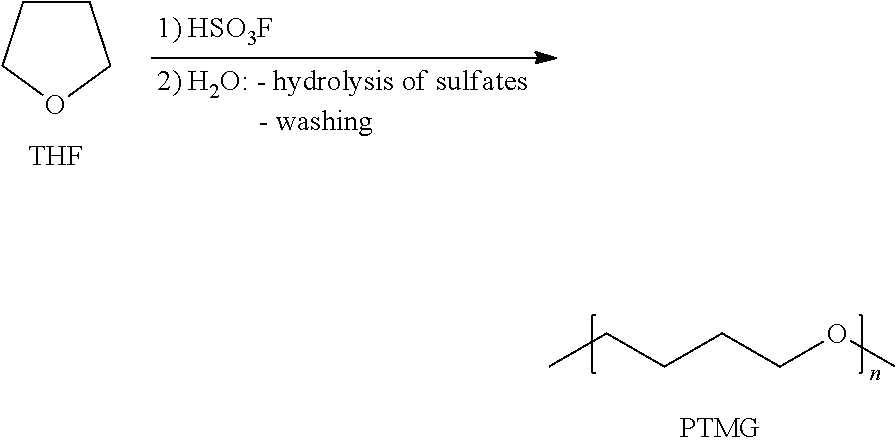Block copolymer derived from renewable materials and method for making such block copolymer
a technology of renewable materials and blocks, applied in the field of thermoplastic elastomers, can solve the problems of water and/or mechanical properties, no renewable alternative to ptmg, and the inability of po3g polyether blocks alone or priplast® polyesters alone to make pebas,
- Summary
- Abstract
- Description
- Claims
- Application Information
AI Technical Summary
Benefits of technology
Problems solved by technology
Method used
Image
Examples
second embodiment
the block copolymer of the present invention comprises at least one polyether flexible block which comprises at least one polytetramethylene glycol obtained at least in part from raw materials of renewable origin and at least one polyester block.
Polyester means, in the sense of the invention, the products of condensation of dicarboxylic acids with dials, and as a general rule, any polymer whose macromolecular backbone contains repeating units containing the ester chemical function.
The polyester blocks (abbreviated hereinafter as PES blocks) are usually made by polycondensation between a dicarboxylic acid and a diol. Suitable carboxylic acids comprise those mentioned above used to form the polyamide blocks. Suitable dials comprise linear aliphatic dials such as ethylene glycol, 1,3-propylene glycol, 1,4-butylene glycol, 1,6-hexylene glycol, branched diols such as neopentylglycol, 3-methylpentane glycol, 1,2-propylene glycol, and cyclic dials such as 1,4-bis(hydroxymethyl)cyclohexane ...
PUM
| Property | Measurement | Unit |
|---|---|---|
| Fraction | aaaaa | aaaaa |
| Fraction | aaaaa | aaaaa |
| Fraction | aaaaa | aaaaa |
Abstract
Description
Claims
Application Information
 Login to View More
Login to View More - R&D
- Intellectual Property
- Life Sciences
- Materials
- Tech Scout
- Unparalleled Data Quality
- Higher Quality Content
- 60% Fewer Hallucinations
Browse by: Latest US Patents, China's latest patents, Technical Efficacy Thesaurus, Application Domain, Technology Topic, Popular Technical Reports.
© 2025 PatSnap. All rights reserved.Legal|Privacy policy|Modern Slavery Act Transparency Statement|Sitemap|About US| Contact US: help@patsnap.com



